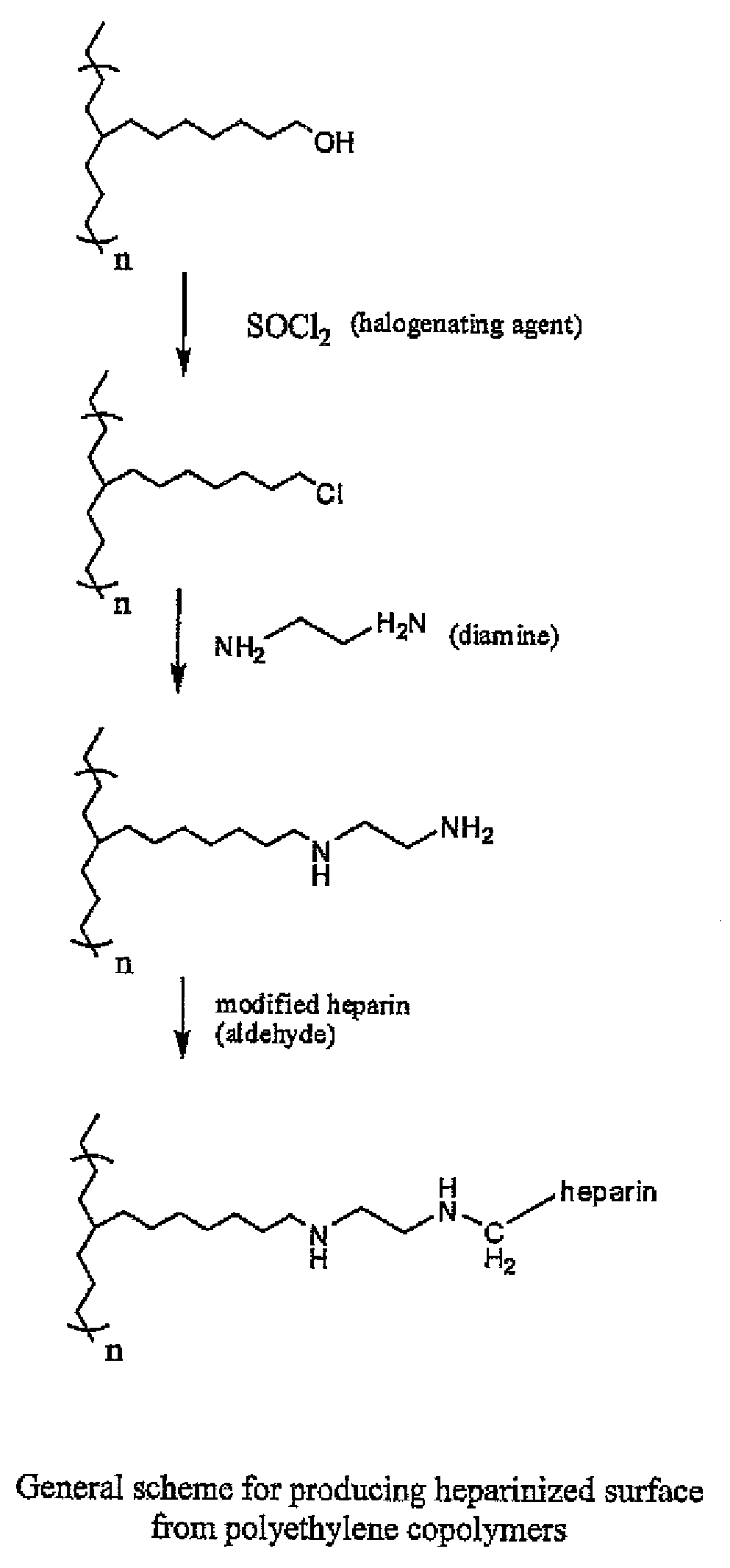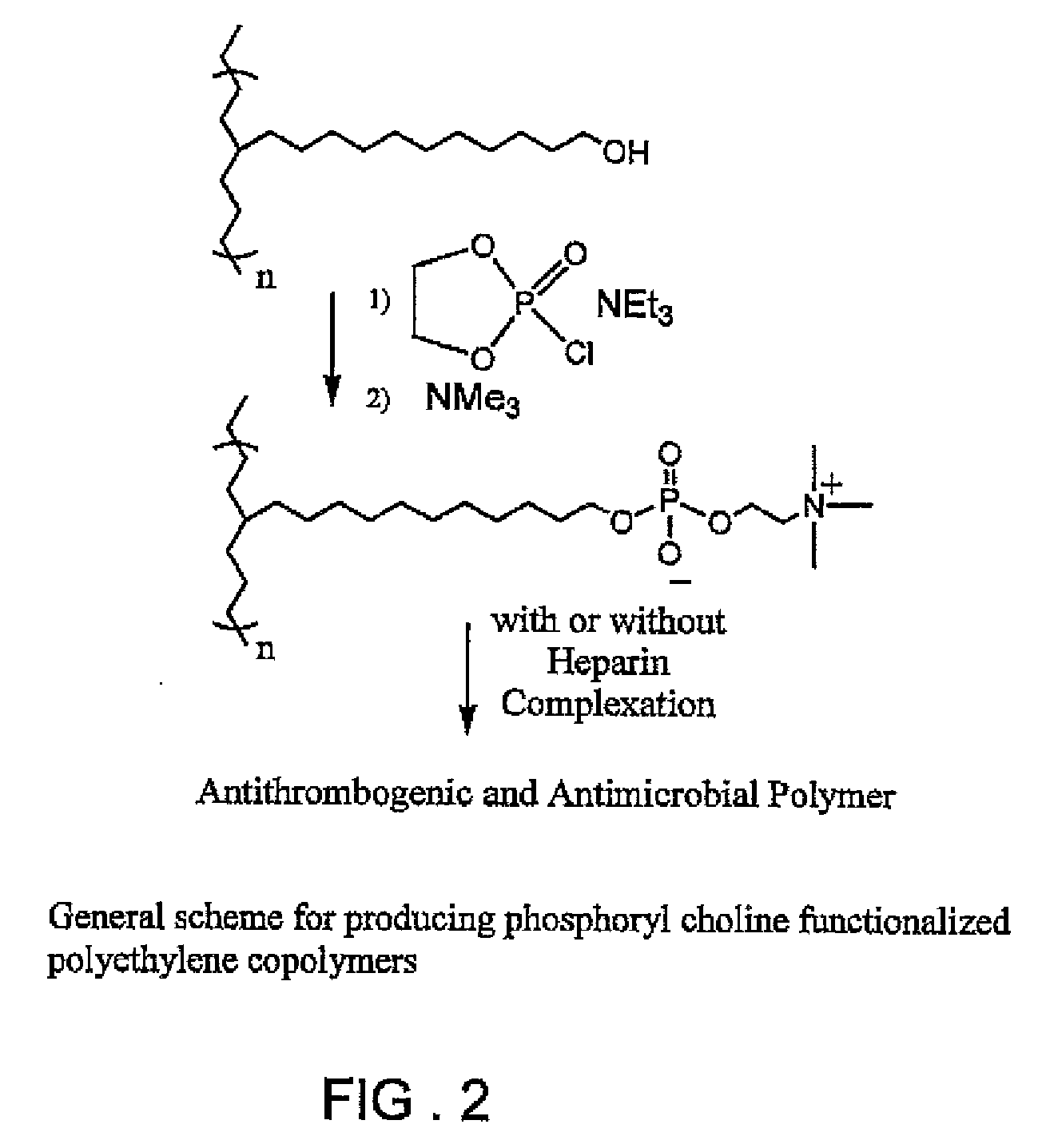Polymers with bio-functional self assembling monolayer endgroups for therapeutic applications and blood filtration
a monolayer end-group and polymer technology, applied in the field of polymer with biofunctional self-assembling monolayer end-groups for therapeutic applications, can solve the problems of sepsis, burn victims, preventing immediate healing by the body, etc., to prevent immediate healing, improve device efficacy, and avoid infection or inflammatory complications.
- Summary
- Abstract
- Description
- Claims
- Application Information
AI Technical Summary
Benefits of technology
Problems solved by technology
Method used
Image
Examples
example 1
Heparinized Micro-Tubing
[0068]An Example of micro-tubing for hemofilter application has an inside diameter (ID) of 240 micron and an outside diameter (OD) of 340 micron, with wall thickness of 50 micron. The micro-tubing is made from thermoplastic materials such as acrylonitrile & sodium methallyl sulfonate copolymer or polyurethanes, and has surface modifying endgroups for subsequent heparinization. Specific example of heparinizing tubing: Into 10 liters DI water, 4.0 grams partially degraded heparin (degraded by nitrous acid or periodate) and 0.36 grams sodium chloride are dissolved. The pH of this solution is adjusted to 3.9-4.0 with dilute hydrochloric acid. Then 0.31 grams NaBH3CN are added and the pH is checked again to ensure it falls between 3.9 and 4.0. The heparin solution is circulated through the medical devices made from micro-tubing with an amino group as the surface modifying endgroup. The circulation of heparin solution is conducted for 48 to 72 hours at room temper...
example 2
Polyurethane Beads with Amine Functional Self Assembling Monolayer Endgroups
[0069]Beads are made from polycarbonate-urethane copolymer synthesized with dodecanediamine end groups. During synthesis, an excess of H2N—(CH2)12—NH2 is reacted at the end of the polyurethane reaction (—NCO / —NH2 ratio kept <1) which creates amine end-groups on the polymer chains. These amine end groups on the polymer will be available for the reaction with partially degraded heparin (with aldehyde groups). This procedure is very similar to the Carmeda process, although no pretreatment / chemical reactions are required to create an aminated surface since the amine functionality is created during polymer manufacturing. Below is the proposed reaction mechanism for this method. Bionate is a thermoplastic polyurethane with aliphatic polycarbonate soft segment and aromatic hard segment. Virtually any other polyurethane midblock may also be used.
[0070]Other diamines with hydrophilic poly(ethylene glycol), such as t...
example 3
Polyurethane Tubing with C18 Self Assembling Monolayer Endgroups Heparinized with Photolinkable Heparin
[0072]Heparin has very low solubility in organic solvents, therefore only a small amount of heparin can be immobilized on polymer surfaces when organic solutions are employed. The approach illustrated in FIG. 3 and outlined as follows avoids this barrier by using an aqueous solution: A polyurethane with octadecanol SAME groups is synthesized; Tubing is extruded from the SAME containing polymer; A Photosensitive group (e.g. aryl azide) is introduced onto heparin by the reaction between —COOH groups along the heparin polymer chain and —NH2 on azidoaniline in the presence of water soluble carbodiimide (WSC). The concentration of heparin can be as high as 10 weight-% t in water. Apply the aqueous solution prepared in Step (c) on the surface of polyurethane. Under UV illumination for 5 minutes, heparin is covalently bound onto the surface through the terminal methyl group of the C18 SA...
PUM
| Property | Measurement | Unit |
|---|---|---|
| Mass | aaaaa | aaaaa |
| Mass | aaaaa | aaaaa |
| Mass | aaaaa | aaaaa |
Abstract
Description
Claims
Application Information
 Login to View More
Login to View More - R&D
- Intellectual Property
- Life Sciences
- Materials
- Tech Scout
- Unparalleled Data Quality
- Higher Quality Content
- 60% Fewer Hallucinations
Browse by: Latest US Patents, China's latest patents, Technical Efficacy Thesaurus, Application Domain, Technology Topic, Popular Technical Reports.
© 2025 PatSnap. All rights reserved.Legal|Privacy policy|Modern Slavery Act Transparency Statement|Sitemap|About US| Contact US: help@patsnap.com



